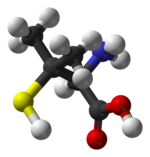青霉胺
此条目的引用需要清理,使其符合格式。 (2021年10月18日) |
青霉胺,以Cuprimine品牌销售,是一种主要用于治疗威尔逊氏病的口服药物[1] [2],还用于患有尿胱氨酸水平高、类风湿性关节炎以及各种重金属中毒的肾结石患者[1][2]。
 | |
 | |
| 临床资料 | |
|---|---|
| 商品名 | Cuprimine, Cuprenyl, Depen |
| 其他名称 | D-penicillamine |
| AHFS/Drugs.com | Monograph |
| MedlinePlus | a618021 |
| 核准状况 | |
| 怀孕分级 |
|
| 给药途径 | By mouth (capsules) |
| ATC码 | |
| 法律规范状态 | |
| 法律规范 |
|
| 药物动力学数据 | |
| 生物利用度 | Variable |
| 药物代谢 | Liver |
| 生物半衰期 | 1小时 |
| 排泄途径 | Kidney |
| 识别信息 | |
| |
| CAS号 | 52-67-5 |
| PubChem CID | |
| IUPHAR/BPS | |
| DrugBank | |
| ChemSpider | |
| UNII | |
| KEGG | |
| ChEBI | |
| ChEMBL | |
| CompTox Dashboard (EPA) | |
| ECHA InfoCard | 100.000.136 |
| 化学信息 | |
| 化学式 | C5H11NO2S |
| 摩尔质量 | 149.21 g·mol−1 |
| 3D模型(JSmol) | |
| |
| |
医疗用途
编辑美国 1970 年批准青霉胺用于医疗用途,并且在世界卫生组织的基本药物清单上[1] [3]。
青霉胺可以用作螯合剂于:
在胱氨酸尿症(一种遗传性疾病,其中高尿胱氨酸水平导致胱氨酸结石形成)中,青霉胺可以与半胱氨酸结合产生比胱氨酸更易溶解的混合二硫化物。[7]
对常规疗法的充分试验没有反应的严重活动性类风湿性关节炎患者,青霉胺可用作缓解疾病的抗风湿药(DMARD) 进行治疗 [9]。尽管由于 TNF 抑制剂、托珠单抗和托法替尼的使用,青霉胺如今已经较少使用。青霉胺通过减少T淋巴细胞数量、抑制巨噬细胞功能、减少IL-1 、减少类风湿因子和防止胶原交联来起作用。
不利影响
编辑骨髓抑制、味觉障碍、厌食、呕吐和腹泻是最常见的副作用,约 20-30% 接受青霉胺治疗的患者会产生, 青霉胺常见的副作用还包括皮疹以及白细胞减少。[10][11][1]其他严重的副作用包括肝病、闭塞性细支气管炎和重症肌无力,[1]并且不建议红斑狼疮患者使用青霉胺, [2]怀孕期间使用也可能会对婴儿造成伤害[2]。
其他可能的不良反应包括:
化学结构
编辑青霉胺是一种三官能有机化合物,由硫醇、胺和羧酸组成,结构上类似于 α-氨基酸半胱氨酸,但在硫醇上有孪生二甲基取代基。像大多数氨基酸一样,是一种无色固体,在生理pH值下以两性离子的形式存在。
青霉胺是一种手性药物,具有一个立体中心,以一对对映异构体的形式存在,如图所示。 (S)对映异构体,具有抗关节炎作用,L-青霉胺(R绝对构型)是有毒的,因为它会抑制吡哆醇(即维生素B6 )起作用。[18] [19]该对映异构体是青霉素的代谢物,但本身没有抗生素特性。 [20]多种青霉胺-铜复合结构已知。 [21]
历史
编辑John Walshe于1956年首次描述了青霉胺在威尔逊病中的使用。 [22]他在服用青霉素的患者(包括他自己)的尿液中发现了这种化合物,并通过实验证实它通过螯合作用增加了尿铜的排泄。他最初难以说服当时的几位世界专家(丹尼·布朗和卡明斯),因为其他人认为威尔逊病的主要问题不在于铜稳态,而是氨基酸代谢问题,并且应该使用二巯基丙醇作为螯合剂。后来经研究证实了以铜-中心理论和D-青霉胺的功效。 Walshe 还率先在 Wilson 开创了其他的螯合剂如三亚乙基四胺和四硫代钼酸盐。 [23]
青霉胺首先由约翰·康福斯在罗伯特·罗宾逊的监督下合成。 [24]
1964 年出现第一个成功案例以来,青霉胺一直用于治疗类风湿性关节炎。 [25]
成本
编辑在美国,Valeant在2016年将药物成本从每月约500美元提高到24,000美元。 [26]
参考文献
编辑- ^ 1.0 1.1 1.2 1.3 1.4 Penicillamine. The American Society of Health-System Pharmacists. [8 December 2016]. (原始内容存档于21 December 2016).
- ^ 2.0 2.1 2.2 2.3 WHO Model Formulary 2008. 2009: 64, 592. ISBN 9789241547659.World Health Organization (2009). Stuart MC, Kouimtzi M, Hill SR (eds.). WHO Model Formulary 2008. pp. 64, 592. hdl:10665/44053. ISBN 9789241547659.
- ^ World Health Organization model list of essential medicines: 21st list 2019. Geneva. 2019. WHO/MVP/EMP/IAU/2019.06. License: CC BY-NC-SA 3.0 IGO.
- ^ Peisach, J.; Blumberg, W. E. A mechanism for the action of penicillamine in the treatment of Wilson's disease. Molecular Pharmacology. 1969, 5 (2): 200–209. PMID 4306792.
- ^ Peterson, R. G.; Rumack, B. H. D-Penicillamine therapy of acute arsenic poisoning. The Journal of Pediatrics. 1977, 91 (4): 661–666. PMID 908992. doi:10.1016/S0022-3476(77)80528-3.
- ^ Hall, A. H. Chronic arsenic poisoning. Toxicology Letters. 2002, 128 (1–3): 69–72. PMID 11869818. doi:10.1016/S0378-4274(01)00534-3.
- ^ 7.0 7.1 Rosenberg, L. E.; Hayslett, J. P. Nephrotoxic Effects of Penicillamine in Cystinuria. JAMA: The Journal of the American Medical Association. 1967, 201 (9): 698–9. PMID 6071831. doi:10.1001/jama.1967.03130090062021.Rosenberg, L. E.; Hayslett, J. P. (1967). "Nephrotoxic Effects of Penicillamine in Cystinuria". JAMA: The Journal of the American Medical Association. 201 (9): 698–9. doi:10.1001/jama.1967.03130090062021. PMID 6071831.
- ^ Steen, V. D.; Medsger Jr, T. A.; Rodnan, G. P. D-Penicillamine therapy in progressive systemic sclerosis (scleroderma): A retrospective analysis. Annals of Internal Medicine. 1982, 97 (5): 652–659. PMID 7137731. doi:10.7326/0003-4819-97-5-652.
- ^ Cuprimine (penicillamine) Capsules for Oral Use. U.S. Full Prescribing Information (PDF). [29 April 2016]. (原始内容 (PDF)存档于8 September 2015).
- ^ Grasedyck, K. D-Penicillamine—side effects, pathogenesis and decreasing the risks. Zeitschrift für Rheumatologie. 1988,. 47 Suppl 1: 17–19. PMID 3063003.
- ^ 11.0 11.1 11.2 Camp, A. V. Penicillamine in the treatment of rheumatoid arthritis. Proceedings of the Royal Society of Medicine. 1977, 70 (2): 67–69. PMC 1542978 . PMID 859814. doi:10.1177/003591577707000201.Camp, A. V. (1977). "Penicillamine in the treatment of rheumatoid arthritis". Proceedings of the Royal Society of Medicine. 70 (2): 67–69. doi:10.1177/003591577707000201. PMC 1542978. PMID 859814.
- ^ 12.0 12.1 Fishel, B.; Tishler, M.; Caspi, D.; Yaron, M. Fatal aplastic anaemia and liver toxicity caused by D-penicillamine treatment of rheumatoid arthritis. Annals of the Rheumatic Diseases. 1989, 48 (7): 609–610. PMC 1003826 . PMID 2774703. doi:10.1136/ard.48.7.609.
- ^ Mitchell, Richard Sheppard; Kumar, Vinay; Abbas, Abul K.; Fausto, Nelson. Robbins Basic Pathology 8th. Philadelphia: Saunders. 2007. ISBN 978-1-4160-2973-1.
- ^ Chalmers, A.; Thompson, D.; Stein, H. E.; Reid, G.; Patterson, A. C. Systemic lupus erythematosus during penicillamine therapy for rheumatoid arthritis. Annals of Internal Medicine. 1982, 97 (5): 659–663. PMID 6958210. doi:10.7326/0003-4819-97-5-659.
- ^ Bolognia, Jean; et al. Dermatology. Philadelphia: Elsevier. 2007. ISBN 978-1-4160-2999-1.2nd edition.
- ^ Underwood, J. C. E. General and Systemic Pathology. Elsevier Limited. 2009. ISBN 978-0-443-06889-8.
- ^ Taylor; Cumming; Corenblum. Successful treatment of D-penicillamine-induced breast gigantism with danazol. Br Med J. January 31, 1981, 282 (6261): 362–3. PMC 1504185 . PMID 6780026. doi:10.1136/bmj.282.6261.362-a.
- ^ Ariens, E.J. Chiral Separations by HPLC. Chichester: Ellis Horwwod, Chichester. 1989: 31–68.
- ^ Aronson, J. K. Meyler's Side Effects of Analgesics and Anti-inflammatory Drugs. Amsterdam: Elsevier Science. 2010: 613. ISBN 9780080932941. (原始内容存档于2017-09-10).
- ^ Parker, C. W.; Shapiro, J.; Kern, M.; Eisen, H. N. Hypersensitivity to penicillenic acid derivatives in human beings with penicillin allergy. The Journal of Experimental Medicine. 1962, 115 (4): 821–838. PMC 2137514 . PMID 14483916. doi:10.1084/jem.115.4.821.
- ^ Birker, Paul J. M. W. L.; Freeman, Hans C. Structure, properties, and function of a copper(I)–copper(II) complex of D-penicillamine: pentathallium(I) μ8-chloro-dodeca(D-penicillaminato)octacuprate(I)hexacuprate(II) n-hydrate. J. Am. Chem. Soc. 1977, 99 (21): 6890–6899. PMID 903530. doi:10.1021/ja00463a019.
- ^ Walshe, J. M. Wilson's disease; new oral therapy. Lancet. Jan 1956, 270 (6906): 25–6. PMID 13279157. doi:10.1016/S0140-6736(56)91859-1.
- ^ Walshe, J. M. The Story of Penicillamine: a Difficult Birth. Mov. Disord. Aug 2003, 18 (8): 853–9. PMID 12889074. doi:10.1002/mds.10458.
- ^ Oakes, Elizabeth H. Encyclopedia of World Scientists. Infobase Publishing. 2007: 156 [2021-10-18]. ISBN 9781438118826. (原始内容存档于2021-10-18).
- ^ Jaffe, I. A. Rheumatoid Arthritis with Arteritis; Report of a Case Treated with Penicillamine. Annals of Internal Medicine. 1964, 61: 556–563. PMID 14218939. doi:10.7326/0003-4819-61-3-556.
- ^ Petersen, Melody. How 4 drug companies rapidly raised prices on life-saving drugs. Los Angeles Times. [27 March 2019]. (原始内容存档于2019-03-27).
外部链接
编辑- Penicillamine. Drug Information Portal. U.S. National Library of Medicine. [2021-10-18]. (原始内容存档于2019-12-05).